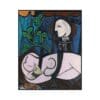William Bouguereau, a French-Academic Painte, was an extremely famous painter in the late 1800’s. He was born in La Rochelle, France, on November 30th 1825. As a young man, Bouguereau put himself through Ecole des Beaux-Arts by making labels for local grocers, and painting portraits of Local Parishioners. Much like many of the other artists of the 19th century, Bouguereau paid careful attention to his meticulous form and technique. The commoners loved Bouguereau, people would storm the Annual Salon every year, and pay unimaginable prices to see and buy his latest work. The public adored Bouguereau, however, according to the official website of The Getty Museum, critics did not feel the same way; “They derided the “bourgeois finickiness” and “contagious mediocrity” of Bouguereau’s mirror-smooth, romanticized paintings of cupids, nudes, and peasant girls.” Some people felt that Bouguereau’s painting represented everything that was wrong with 19th century academic art. The impressionist hated his work, and this type of art was exactly what they were trying to move away from.
One of Bouguereau’s most famous works, “A young Girl Defending Herself Against Eros” is an astounding painting that, the moment you set eyes on the painting, the aesthetics will catch you off guard. The incredible attention to detail in the faces of the two characters is what really attracted me to it. It is astonishing how perfectly Bouguereau demonstrates the perfect emotions. It is an academic representation of a woman playfully resisting cupid’s arrow, secretly wanting it, yet clearly shying away from it. This can be interpreted as symbolic of how hard love is to resist at times. Even though we don’t want to get hurt by the arrow, we still all secretly want it. I think that the value he uses really makes it light hearted and even kind of a funny painting. The texture and space he uses also really gives the painting its traditional academic feel, which is simple while still invoking emotions.
Disclaimer: The views and opinions expressed in this article are those of the authors and do not necessarily reflect the official policy or position of Irish Artmart.



